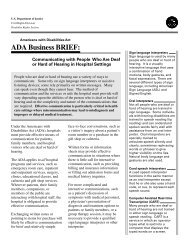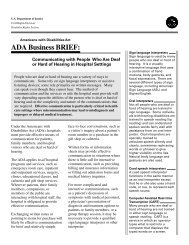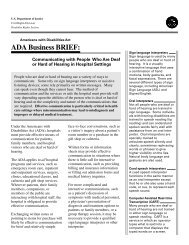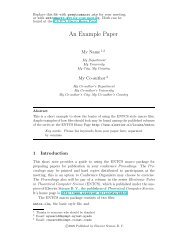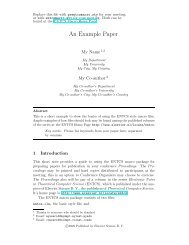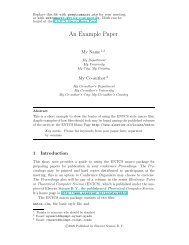Test - 1
Create successful ePaper yourself
Turn your PDF publications into a flip-book with our unique Google optimized e-Paper software.
U.S. Department of Justice<br />
Civil Rights Division<br />
Disability Rights Section<br />
Americans with Disabilities Act<br />
ADA Business BRIEF:<br />
Communicating with People Who Are Deaf<br />
or Hard of Hearing in Hospital Settings<br />
People who are deaf or hard of hearing use a variety of ways to<br />
communicate. Some rely on sign language interpreters or assistive<br />
listening devices; some rely primarily on written messages. Many<br />
can speak even though they cannot hear. The method of<br />
communication and the services or aids the hospital must provide will<br />
vary depending upon the abilities of the person who is deaf or hard of<br />
hearing and on the complexity and nature of the communications that<br />
are required. Effective communication is particularly critical in health<br />
care settings where miscommunication may lead to misdiagnosis and<br />
improper or delayed medical treatment.<br />
Under the Americans with<br />
Disabilities Act (ADA), hospitals<br />
must provide effective means of<br />
communication for patients,<br />
family members, and hospital<br />
visitors who are deaf or hard of<br />
hearing.<br />
The ADA applies to all hospital<br />
programs and services, such as<br />
emergency room care, inpatient<br />
and outpatient services, surgery,<br />
clinics, educational classes, and<br />
cafeteria and gift shop services.<br />
Wherever patients, their family<br />
members, companions, or<br />
members of the public are<br />
interacting with hospital staff, the<br />
hospital is obligated to provide<br />
effective communication.<br />
Exchanging written notes or<br />
pointing to items for purchase will<br />
likely be effective communication<br />
for brief and relatively simple<br />
face-to-face conversations, such as<br />
a visitor’s inquiry about a patient’s<br />
room number or a purchase in the<br />
gift shop or cafeteria.<br />
Written forms or information<br />
sheets may provide effective<br />
communication in situations where<br />
there is little call for interactive<br />
communication, such as providing<br />
billing and insurance information<br />
or filling out admission forms and<br />
medical history inquiries.<br />
For more complicated and<br />
interactive communications, such<br />
as a patient’s discussion of<br />
symptoms with medical personnel,<br />
a physician’s presentation of<br />
diagnosis and treatment options to<br />
patients or family members, or a<br />
group therapy session, it may be<br />
necessary to provide a qualified<br />
sign language interpreter or other<br />
interpreter.<br />
Sign language interpreters<br />
Sign language is used by many<br />
people who are deaf or hard of<br />
hearing. It is a visually<br />
interactive language that uses<br />
a combination of hand<br />
motions, body gestures, and<br />
facial expressions. There are<br />
several different types of sign<br />
language, including American<br />
Sign Language (ASL) and<br />
Signed English.<br />
Oral interpreters<br />
Not all people who are deaf or<br />
hard of hearing are trained in<br />
sign language. Some individuals<br />
with hearing disabilities are<br />
trained in speech reading (lip<br />
reading) and can understand<br />
spoken words fairly well with<br />
assistance from an oral interpreter.<br />
Oral interpreters are<br />
specially trained to<br />
articulate speech silently and<br />
clearly, sometimes rephrasing<br />
words or phrases to give<br />
higher visibility on the lips.<br />
Natural body language and<br />
gestures are also used.<br />
Cued speech interpreters<br />
A cued speech interpreter<br />
functions in the same manner<br />
as an oral interpreter except<br />
that he or she also uses a hand<br />
code, or cue, to represent each<br />
speech sound.<br />
Computer Assisted Real-time<br />
Transcription (CART)<br />
Many people who are deaf or<br />
hard of hearing are not trained<br />
in either sign language or<br />
speech reading. CART is a<br />
service in which an operator<br />
types what is said into a<br />
computer that displays the<br />
typed words on a screen.
Communicating with People Who Are Deaf or Hard of Hearing in Hospital Settings (continued)<br />
Situations where an interpreter<br />
may be required for effective<br />
communication:<br />
• discussing a patient’s<br />
symptoms and medical<br />
condition, medications, and<br />
medical history<br />
• explaining and describing<br />
medical conditions, tests,<br />
treatment options,<br />
medications, surgery and<br />
other procedures<br />
• providing a diagnosis,<br />
prognosis, and<br />
recommendation for<br />
treatment<br />
• obtaining informed consent<br />
for treatment<br />
• communicating with a<br />
patient during treatment ,<br />
testing procedures, and<br />
during physician’s rounds<br />
Hospitals may need to provide an<br />
interpreter or other assistive<br />
service in a variety of situations<br />
where it is a family member or<br />
companion rather than the patient<br />
who is deaf or hard of hearing.<br />
For example, an interpreter may be<br />
necessary to communicate where<br />
the guardian of a minor patient is<br />
deaf, to discuss prognosis and<br />
treatment options with a patient’s<br />
spouse or partner who is hard of<br />
hearing, or to allow meaningful<br />
participation in a birthing class for<br />
a prospective new father who is<br />
deaf.<br />
Individuals with hearing<br />
disabilities have different<br />
communication skills and the<br />
hospital should consult with each<br />
individual to determine what aids<br />
or services are necessary to<br />
provide effective communication<br />
in particular situations.<br />
It is inappropriate to ask family<br />
members or other companions to<br />
interpret for a person who is deaf<br />
or hard of hearing. Family<br />
members may be unable to<br />
interpret accurately in the<br />
emotional situation that often<br />
exists in a medical emergency.<br />
Hospitals should have<br />
arrangements in place to ensure<br />
that qualified interpreters are<br />
readily available on a scheduled<br />
basis and on an unscheduled basis<br />
with minimal delay, including<br />
on-call arrangements for<br />
after-hours emergencies. Larger<br />
facilities may choose to have<br />
interpreters on staff.<br />
• providing instructions for<br />
medications, post-treatment<br />
activities, and follow-up<br />
treatments<br />
• providing mental health<br />
services, including group or<br />
individual therapy, or<br />
counseling for patients and<br />
family members<br />
• providing information about<br />
blood or organ donations<br />
• explaining living wills and<br />
powers of attorney<br />
• discussing complex billing or<br />
insurance matters<br />
• making educational<br />
presentations, such as<br />
birthing and new parent<br />
classes, nutrition and weight<br />
management counseling,<br />
and CPR and first aid training<br />
Sign language or other<br />
interpreters must be<br />
qualified. An interpreter<br />
is qualified if he or she<br />
can interpret<br />
competently, accurately,<br />
and impartially. In the<br />
hospital setting, the<br />
interpreter must be<br />
familiar with any<br />
specialized vocabulary<br />
used and must be able to<br />
interpret medical terms<br />
and concepts. Hospital<br />
personnel who have a<br />
limited familiarity with<br />
sign language should<br />
interpret only in<br />
emergency situations for<br />
a brief time until a<br />
qualified interpreter can<br />
be present.<br />
A doctor uses a sign language interpreter to<br />
communicate with a patient who is deaf.<br />
2
Communicating with People Who Are Deaf or Hard of Hearing in Hospital Settings (continued)<br />
For training or other educational<br />
services offered to patients or<br />
members of the public, additional<br />
aids and services such as note<br />
takers, captioned videos, and<br />
assistive listening systems may be<br />
necessary for effective<br />
communication.<br />
Hospitals should develop<br />
protocols and provide training to<br />
ensure that staff know how to<br />
obtain interpreter services and<br />
other communication aids and<br />
services when needed by persons<br />
who are deaf or hard of hearing.<br />
It is helpful to have signs and<br />
other types of notices to advise<br />
persons with disabilities that<br />
services and assistance are<br />
available and what they need to do<br />
to obtain them. It is most useful to<br />
post signs at locations where<br />
patients or visitors typically seek<br />
information or assistance and to<br />
include information in general<br />
information packets.<br />
Hospitals cannot charge patients or<br />
other persons with hearing<br />
disabilities an extra fee for<br />
interpreter services or other<br />
communication aids and services.<br />
For telephone communications,<br />
many people who are deaf or hard<br />
of hearing use a teletypewriter<br />
(TTY, also known as a TDD)<br />
rather than a standard telephone.<br />
These devices have a keyboard<br />
and a visual display for<br />
exchanging written messages over<br />
the telephone.<br />
The ADA established a free<br />
nationwide relay network to<br />
handle voice-to-TTY and TTY-tovoice<br />
calls. Individuals may use<br />
this network to call the hospital<br />
from a TTY. The relay consists of<br />
an operator with a TTY who<br />
receives the call from a TTY user<br />
and then places the call to the<br />
hospital. The caller types the<br />
message into the TTY and the<br />
operator relays the message by<br />
voice to the hospital staff person,<br />
listens to the staff person’s<br />
response, and types the response<br />
back to the caller. The hospital<br />
must be prepared to make and<br />
receive relay system calls, which<br />
may take a little longer than voice<br />
calls. For outgoing calls to a TTY<br />
user, simply dial 7-1-1 to reach a<br />
relay operator.<br />
If telephones and televisions are<br />
provided in patient rooms, the<br />
hospital must provide patients who<br />
are deaf or hard of hearing<br />
comparable accessible equipment<br />
upon request, including TTY’s,<br />
telephones that are hearing-aid<br />
compatible and have volume<br />
control, and televisions with<br />
closed captioning or decoders.<br />
Visual alarms are not required in<br />
patient rooms. However, hospital<br />
evacuation procedures should<br />
include specific measures to<br />
ensure the safety of patients and<br />
visitors who are deaf or hard of<br />
hearing.<br />
A hospital patient uses a TTY in his hospital room.<br />
A hospital need not provide<br />
communication aids or services if<br />
doing so would fundamentally<br />
alter the nature of the goods or<br />
services offered or would result in<br />
an undue burden.<br />
3
Communicating with People Who Are Deaf or Hard of Hearing in Hospital Settings (continued)<br />
Certain built-in communication<br />
features are required for hospitals<br />
built or altered after the effective<br />
date of the ADA:<br />
• Visual alarms must be provided<br />
in all public and common-use<br />
areas, including restrooms,<br />
where audible alarms are<br />
provided.<br />
• TTY’s must be provided at<br />
public pay phones serving<br />
emergency, recovery, or waiting<br />
rooms and at least one TTY<br />
must be provided at other<br />
locations where there are four<br />
or more pay phones.<br />
• A certain percentage of public<br />
phones must have other<br />
features, such as TTY plug-in<br />
capability, volume controls, and<br />
hearing-aid compatibility.<br />
Consult the ADA Standards for<br />
Accessible Design for more<br />
specific information. [ADA<br />
Standards 4.1.3(17), 4.31]<br />
ADA Information<br />
You may view or download ADA<br />
information on the ADA website.<br />
This website provides access to the<br />
ADA Business Connection, ADA<br />
design standards, regulations,<br />
policy letters, technical assistance<br />
materials, and general ADA<br />
information. It also provides links<br />
to other Federal agencies and news<br />
about new ADA requirements and<br />
enforcement efforts.<br />
www.ada.gov<br />
If you have specific questions<br />
concerning the ADA, call the<br />
Department of Justice ADA<br />
Information Line.<br />
(800) 514-0301 (voice)<br />
(800) 514-0383 (TTY)<br />
A man uses a TTY that is connected to a pay telephone<br />
in a hospital emergency room waiting area.<br />
Duplication is encouraged<br />
October 2003<br />
4



